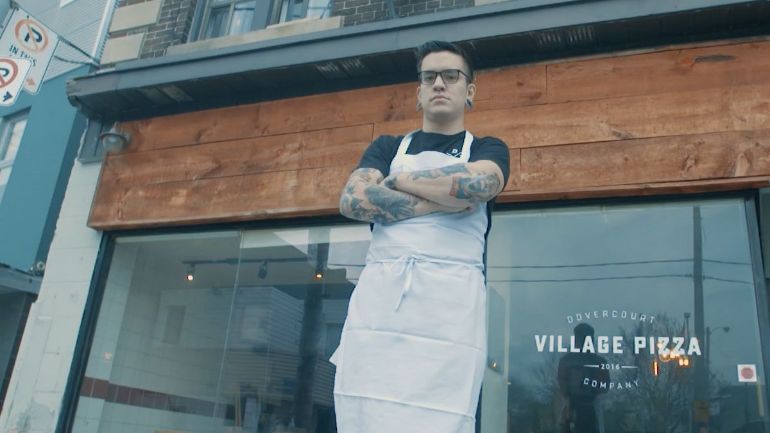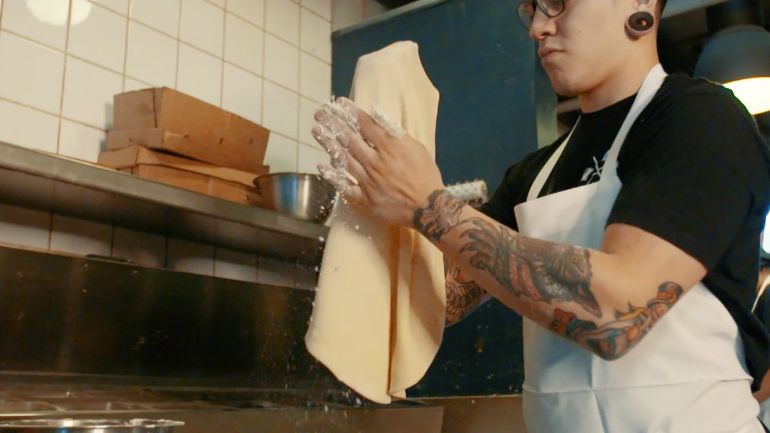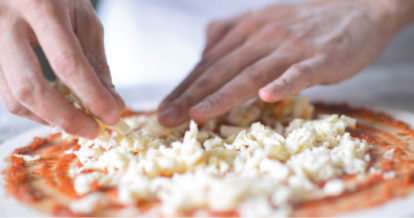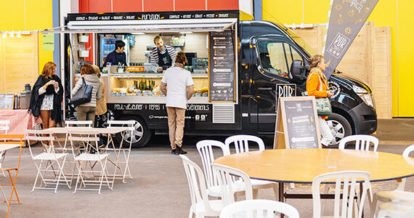The competition for diner dollars is fierce in fast casual restaurants.
If you own a fast casual restaurant, we don’t need to tell you that it’s a jungle out there. Instead, we’re going to tell you how you can stand out from the crowd.
So what does it take to compete in the world of fast casual restaurants? Jake Holton, the co-owner of Village Pizza in Toronto gives us his tips on how to beat the competition.
1. Quality Control: A Simple, Yet Difficult Concept
High-quality food is really what makes fast casual stand out from fast food.
Jake states the importance of a quality product you believe in. Sounds simple, right? In theory, yes, but in practice, sourcing high-quality ingredients isn’t always easy.
When seasonality affects your source of ingredients, choose comparable substitutes that are in season instead of settling for subpar produce. And make sure you have backup suppliers in case your current suppliers run out of stock, so that you can maintain consistency in quality.
If you offer takeout or delivery, make sure you’ve “delivery-proofed” your recipes so that they travel well. Your takeout and delivery diners may not be dining in, but that doesn’t mean their experience should be anything less than if they were actually eating at your restaurant.
Details matter here. Staying true to maintaining the standard of quality of your product is key.
2. Leveling Up on Guest Experience
When diners go out, service is a big part of the overall experience. You need to provide a great atmosphere so that your customers are having a consistently positive experience.
Make an effort to greet every customer – even when you’re slammed. A “Hi, I’ll be with you in just a minute” goes a long way.
Make a conscious effort to get to know your customers by name, especially the regulars. You get bonus points if you can remember their preferences. Why? Because no one wants to feel like a transaction or a number.
When diners choose to spend money at your restaurant, they’re trusting you. They are choosing to spend money at your restaurant because you’ve won over their trust from past experiences. Always remember this saying for customer service: “Trust takes years to build, seconds to break, and forever to repair.”

3. Create and Maintain a Unique Brand
Today’s diners have myriad tools in their arsenal to weed out potential bad experiences. That’s why brand management is an important part of standing out from the rest.
But what is brand management? It is the deliberate presentation of your business to the world. It’s how you communicate who you are and what you do, how you live up to the promises you make in your advertising, and how you set yourself apart from your competitors.
But brand management goes beyond traditional advertising where you’re trying to drive customers to spend money at your restaurant. Yes, it’s important to use your digital presence to advertise a new menu item, but it’s equally important to feature content that builds brand trust and thus loyalty.
For example: tell stories about people and companies you love to work with. Share where you get the pepperoni for your pizza and give people a “behind the scenes” look at how you make said pizza.
Your “digital storefront” is just as important as your physical storefront. As consumer behaviors now shift to online reviews and also online ordering through third-party apps like Uber Eats and Grubhub, it’s important to make sure you’re easily found.
4. Tap into OPN (Other People’s Networks)
The best way to tap into prospective customers is to go outside of your existing network.
Jake says, “The best partnerships are with those that will support you and continue to be engaged through the entire process – and will commit to including your brand in their promotional materials.”
When a partnership is a one-way street, you may not get the kind of engagement you want through your alliances. So make sure you set the partnership up for success by setting expectations early. You can do this by:
1. Doing your due diligence.
When you “get into bed” with someone, anything they do can come back to haunt you, from the way they respond or interact on social media to the way they treat their own customers.
So how do you make sure a prospective partner is right for you? Creep their social media feeds and Google them to see what people are saying about them. You can bet they’re also Googling you.
Seek out partners who are going to cross-promote your brand. Make sure your partners are willing to invest in your brand visibility on top of their own. Send your logo so your partner can use it in their promotional materials.
2. Seeking out partners that share common ground with your own brand or audience.
A pizza restaurant may want to partner up with a local music venue that doesn’t offer food because who hasn’t grabbed a slice and a beer during those late night jam sessions? You may even want to create a pizza special that’s inspired by a song. Pizza My Heart, anyone?
3. Align on the channels you’ll use to promote your partnership.
Do your research. For example, if you’re mostly going to promote online, you’ll want to know the size of their newsletter database. How many Instagram followers do they have? What are their engagement rates like?
Partnerships are great, but if you have 10,000 people on your mailing list and they only have 500, then the partnership is probably not going to benefit you as much.
5. Food Trends: Yay or Nay?
“I care about industry trends … to a degree,” says Jake.
Social media is a great source to spot food trends because “restaurants are constantly posting everything they do and we see it everyday,” he adds.
For example, a quick Google search of “best pizza restaurants in [your city]” will give you a list of competitors to follow. Even if they’re not within a 5km radius of you, what they’re doing clearly resonates with diners. With the rise in popularity of online ordering, they may very well end up being your direct competition.
Follow popular food blogs and food publications to spot trends early – but always assess whether they are right for your business. Should you “chase trends” for the sake of being trendy?
Ask yourself the following questions to find out:
- Does this food trend fit with my current product offering?
- Is this trend drastically different than what we’re currently offering?
- Is there an existing gap that this food trend can fill in my menu that isn’t already being met in the community?
- How well will our customers adopt this new trend?
“Something that works well in one place doesn’t necessarily translate into what you’re doing. Latching on to a trend for the sake of being trendy doesn’t make sense if it alienates your customers. Stay true to your business,” says Jake.

6. Always Be Open to Changing Your Menu
The only constant in life is change.
You’re always going to have your staple menu items that have stood the test of time and are your bread and butter, but adding new menu items or specials is a great way to find a new bestseller.
Adding new menu items is also a great way to generate new social media content, from your own account and on your diners’ accounts – because everyone likes bragging rights to being among the first to have tried something new.
You can also consider running a LTO to generate excitement over your menu offering. What is an LTO? An LTO is a limited time offer that is available for a specific and often short period of time.
So how do you go about testing new menu items to make sure they’re worth it?
“If we think we have a really great idea for a menu item, we’ll put it on as a seasonal item and workshop it that way,” says Jake. “Some items we think are going to sell really well don’t, and then on other hand, some items that sell well don’t end up being cost effective long-term. If the demand and cost line up, then the item becomes a menu regular,” he says.
7. Fill a Need That’s Not Already Met
First, a short story: Jake is not a first-time restaurateur. His first place, Hub Coffee Shop, was owned with Asher Miller and their third partner, Yauca de Almeida.
de Almeida owned the space next door, Yauca’s Lounge, a bar with live music. Yauca had tried a few times to serve food in the bar – but nothing ever seemed to click. So when he walked into Hub Coffee and saw how busy it was, he approached Jake and Asher to come up with a food concept.
Jake and Asher were sitting at the Hub one night after work. They were hungry for dinner and wanted pizza. As they were searching online for a place in their Bloorcourt neighborhood, all they could find were fast food chains. That or order from Maker’s Pizza, who at the time was one of the few pizzerias making niche, quality pizza in downtown Toronto.
So right then, the light bulb came on and they opened Village Pizza in Bloorcourt. Since then they have expanded and opened up a second location at Dundas and Bathurst.
Jake says, “If we opened another fast food franchise pizza place in our neighborhood, that probably wouldn’t have worked. But we saw the opportunity for niche, high-quality pizza in a market where it didn’t exist, and it’s made us successful.”
8. Great People Will Beat Your Competition’s Good People
Hiring good staff, especially good management staff, will be your key differentiator every time.
When hiring, Jake looks for people with great communication skills. A great assessment tool for gauging this skill is body language.
“If someone walks into an interview and can’t look you in the eye. Or they send you an email back in response to a resume and can’t send you an intelligible email; do you want them to be negotiating with your suppliers or communicating with your customers?” Jake asks.
Jake says that while it’s difficult to pay people a living wage given slim margins in foodservice, higher wages have meant “an incredibly reduced stress load” so that he and his business partners can focus on growing the business versus.
9. R-E-S-P-E-C-T
Jake’s last and final piece of advice is to treat others with respect – from customers to employees to suppliers.
“We were all working the floor until very recently,” he says. “There’s an element of ‘practice what you preach.’”
Set clear expectations and communicate them well. Reward people who come through with those expectations, and don’t stick with the people who can’t.
Beating the competition is about making sure you serve a quality product, provide a memorable customer experience, and maintain a positive brand image. If you fill a niche that isn’t being met within the marketplace, hire good people, and build a great company culture, you’ll be setting yourself up to stand out.
Free social media templates for your restaurant
Sign up for our free weekly TouchBistro Newsletter







